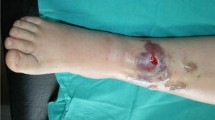Abstract
Background
Pyoderma gangrenosum (PG) is an uncommon condition. Literature on the management of peristomal PG (PPG) is sparse. In the absence of randomized controlled trials the reporting of case series is potentially helpful to the management of this uncommon disease.
Objective
In this study we report our experience with topical corticosteroid therapy for 14 consecutive cases of PPG.
Methods
A clinical diagnosis PPG was made by a trained dermatologist using the appropriate investigations where necessary.
Results
The majority of the cases presented were managed with simple topical corticosteroids, occasionally in combination with a change of dressing. In 8/14 (57%) cases ulcer resolution was achieved within 3 months with topical treatment alone or topical treatment plus a change of dressing to a silicone-based product applied directly to the wound under the normal base plate of the stoma bag.
Conclusion
Our experience suggests that a significant proportion of PPG can be managed by topical treatment alone. The simple topical treatment allows the patient to continue use of stoma care products while minimizing the potential for side effects.
Sommaire
Antécédents
Pyoderma gangrenosum (PG) est une condition rare. Rares sont également les publications spécialisées traitant de la gestion de PG péristomiale (PGP). En I’absence d’essais randomisés contrôlés, I’exposition de séries de cas peut s’avérer utile dans la gestion de cette maladie fortuite.
Objectif
Dans la présente étude, nous relatons notre expérience avec 14 cas consécutifs de PGP traités par corticoïdes topiques.
Méthodes
Le diagnostic clinique de PGP a été posé par un dermatologue qualifié, au moyen des investigations appropriées au besoin.
Résultats
La plupart des cas ont été traités aux corticoïdes topiques, parfois avec changement du pansement. Dans huit des cas (57%), les ulcères ont été guéris dans un intervalle de trois mois, au moyen du traitement topique seul ou en combinaison avec le remplacement du pansement par un produit à base de silicone, appliqué directement sur la blessure, sous la base normale de la poche de stomie
Conclusion
Notre expérience suggére qu’une bonne proportion des PGP peut être gérée par traitement topique seul. Ce traitement permet au patient de continuer à utiliser ses produits de stomie tout en minimisant les effets secondaires.

Similar content being viewed by others
References
CC Lyon AJ Smith MH Beck et al. (2000) ArticleTitleParastomal pyoderma gangrenosum: clinical features and management J Am Acad Dermatol 42 992–1002 Occurrence Handle10.1016/S0190-9622(00)90292-5 Occurrence Handle10827402
CC Lyon AJ Smith CE Griffiths et al. (2000) ArticleTitlePeristomal dermatoses: a novel indication for topical steroid lotions J Am Acad Dermatol 43 IssueID4 679–682 Occurrence Handle10.1067/mjd.2000.106237 Occurrence Handle11004626
J Wenzel R Gerdsen WP Dormston et al. (2002) ArticleTitleTopical treatment of pyoderma gangrenosum: Dermatology 205 IssueID3 221–223 Occurrence Handle10.1159/000065843 Occurrence Handle12399665
D Mimouni GJ Anholt DJ Kouba et al. (2003) ArticleTitleInfliximab for peristomal pyoderma gangrenosum Br J Dermatol 148 IssueID4 813–816 Occurrence Handle10.1046/j.1365-2133.2003.05294.x Occurrence Handle12752145
RB Mlika I Riahi S Fenniche et al. (2002) ArticleTitlePyoderma gangrenosum. A report of 21 cases Int J Dermatol 41 65–68 Occurrence Handle10.1046/j.1365-4362.2002.01329.x Occurrence Handle11982638
DG Sheldon LL Sawchuk RA Kozarek et al. (2000) ArticleTitleTwenty cases of peristomal pyoderma gangrenosum: diagnostic implications and management Arch Surg 135 IssueID5 564–568 Occurrence Handle10.1001/archsurg.135.5.564 Occurrence Handle10807281
ML Bennett JM Jackson JL Jorizzo et al. (2000) ArticleTitlePyoderma gangrenosum. A comparison of typical and atypical forms with an emphasis on time to remission. Case review of 86 patients from 2 institutions Medicine (Baltimore) 79 IssueID1 37–46 Occurrence Handle10.1097/00005792-200001000-00004
AP Hughes JM Jackson JP. Callen (2000) ArticleTitleClinical features and treatment of peristomal pyoderma gangrenosum JAMA 284 IssueID12 1546–1548 Occurrence Handle10.1001/jama.284.12.1546 Occurrence Handle11000649
BA Cairns CA Herbst BR Sartor et al. (1994) ArticleTitlePeristomal pyoderma gangrenosum and inflammatory bowel disease Arch Surg 129 IssueID7 769–772 Occurrence Handle7912923
FC Powell WP Su HO Perry et al. (1996) ArticleTitlePyoderma gangrenosum: Classification and management J Am Acad Dermatol 34 IssueID3 395–409 Occurrence Handle10.1016/S0190-9622(96)90428-4 Occurrence Handle8609250
K. Olson (1971) ArticleTitlePyoderma gangrenosum with systemic L.E Acta Derm Venereol 51 IssueID3 233–234 Occurrence Handle4103039
LP Stolman D Rosenthal R Yaworsky et al. (1975) ArticleTitlePyoderma gangrenosum and rheumatoid arthritis Arch Dermatol 111 IssueID8 1020–1023 Occurrence Handle10.1001/archderm.111.8.1020 Occurrence Handle786171
MV Griensven EC Bergijk JJ Baelde et al. (1997) ArticleTitleDifferential effects of sex hormones on autoantibody production and proteinuria in chronic graft-versus-host disease-induced experimental lupus nephritis Clin Exp Immunol 107 IssueID2 254–260 Occurrence Handle10.1111/j.1365-2249.1997.261-ce1141.x Occurrence Handle9030861
RA Treurniet EC Bergijk JJ Baelde et al. (1993) ArticleTitleGender-related influences on the development of chronic graft-versus-host disease-induced experimental lupus nephritis Clin Exp Immunol 91 IssueID3 442–448 Occurrence Handle8443966
Author information
Authors and Affiliations
Corresponding author
About this article
Cite this article
Nybaek, H., Olsen, A.G., Karlsmark, T. et al. Topical Therapy for Peristomal Pyoderma Gangrenosum. J Cutan Med Surg 8, 220–223 (2004). https://doi.org/10.1007/s10227-004-0105-9
Published:
Issue Date:
DOI: https://doi.org/10.1007/s10227-004-0105-9




